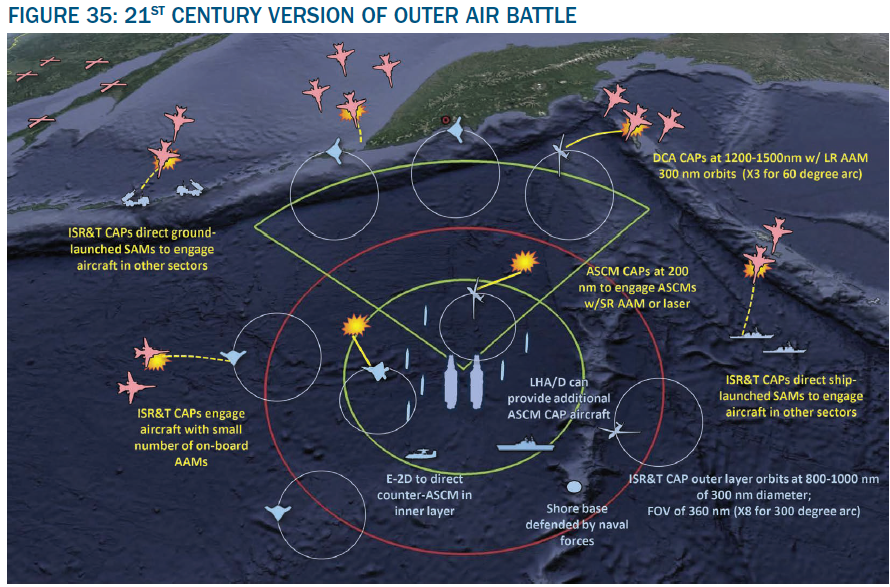GunshipDemocracy wrote:I was replying to that



LMFS in previous post wrote:...not counting AEW capabilities of fighters and UAVs,
which wont be small. This role needs to be
expanded in the future due to extended range of AShM.
I referred specifically to the ones launched from aircraft, since those are the ones capable of being carried further and further due to inflight refuelling entering carrier operations in the short term. The carrier will stay far and the fighters will carry the AShM to its launching point, which will be itself as far as possible from the attacked carrier in order to complicate interception before missile launch. This generates a huge are to be covered that demands in turn many more AEW assets in order to cover properly the defensive perimeter of the fleet. For instance, if you have to defend against a Kinzhal with 2000 km range and in the worst case where you can't define the vector of attack, you have a perimeter of 12500 km... good luck with that!


when CSG is supposed to control bubble with 3,000km radius + PGS 30mins of global reach + c4I what is theatre?
Yeah, good question...

Advice is ok, but in order to achieve in the most effective way the requierements of the customer, in this case the Russian Ministry of Defense and the Russian Navy.
Advice to convince your customer about to change his/her requierements is habitually unsuccessfull, and not well regarded by custormers.
Not sure if you are getting what I mean or if maybe I am not getting you. Krylov is not designing ships. Their job is, as far as I understood it:
> Determine technological strategies and roadmaps for the development of navy
> Make theoretical proposals to the RuN to ensure the right questions are debated
> Discuss and evaluate the proposals of the actual design bureaus from a technological point of view.
So, their job as a "scientific consultant" to the MoD is precisely to think outside the box and challenge existing paradigms, to ensure the decisions taken are technologically sound now and in the future. It is a massively important job and they must be capable of developing with full freedom, despite coming up with ideas that are not 100% what RuN had in mind. There are few things as dangerous as commonly accepted "truths" that are no such, and these are specially abundant in complex technological environments.
Agree that in some moment in time a decision must be taken, for good or for bad, and I expect Putin's MoD going ahead with their planned dates and steps, despite the difficulties of the decision and the internal debate. It is not the best moment since the discourse against the carriers is now more convincing than probably ever. But if in some years time effective means against hypersonic weapons are developed, they will recover their relevance again and Russia could have lost decades due to inaction. So I guess MoD will hedge against such possible developments and carry on with some type of carrier, at least in a basic form to deploy with expeditionary forces and protect SLOCs. There are, in function of the philosophy used, different ways, all of which are compelling in some way, to tackle the issue:
> Small carrier for STOVL should be cheaper and should be more resilient in that such planes could land or take off in case of emergency with damaged decks (for instance after a leaker impacts, which could disable a conventional carrier despite not sending it to the bottom). It is a possibility but:
- How much cheaper will the carrier be? Comparisons with USN are misleading since in US those vessels are auxiliary ones (always under CVN umbrella). In RuN they would be capital ships and armed / equipped accordingly
- How much would be spent in the air wing, if it had to be developed from scratch? Many billions would be needed and costs per unit could be astronomic.
- Could this ship be unified with LHDs, since carriers are normally way bigger? Or would Russia compromise with smallish air wings on board?
> Big CATOBAR CVN would have the maximum capability but would be very expensive and not specially survivable, at least they would be easy to be disabled in case an impact reaches the deck, rendering a huge investment vulnerable in a war. In what respects the capability they and their air wing are clearly the best but it all depends in what Russia wants exactly to do with them and if they see use in spending so big on them.
> STOBAR carrier along the lines of K but in a modern version should be cheaper than a CATOBAR and not necessarily much more expensive than the STOVL carrier as far as I see it (almost same systems in the end), while potentially very capable. If the design allows for inclusion of EMALS in the moment the technology is mature it would be a future-proof solution too. Personally I would see a double landing deck (using newly gained deck width from multihull layout) to gain in survivability, but I admit this may be far fetched

Russia has a tendency to go for a balanced solution so I would say the third option is the strongest one, but first one could have defenders in the current circumstances, and if for instance the STOVL fighters were co-developed with China there would be a strong enabling effect. Why not a mixed STOBAR/STOVL air wing as there was already in past Soviet carriers? It all depends in Russia's naval posture in the end.










 kvs
kvs